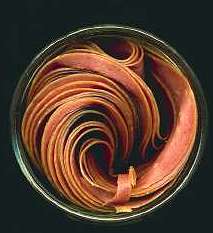 Modern chipped beef product, showing coiled packing | |
| Type | Meat |
|---|---|
| Place of origin | United States |
| Main ingredients | Beef |
Chipped beef is a form of pressed, salted and dried beef that has been sliced into thin pieces. Some makers smoke the dried beef for more flavor. The modern product consists of small, thin, flexible leaves of partially dried beef, generally sold compressed together in jars or flat in plastic packets. The processed meat producer Hormel once described it as "an air-dried product that is similar to bresaola, but not as tasty." [1]

